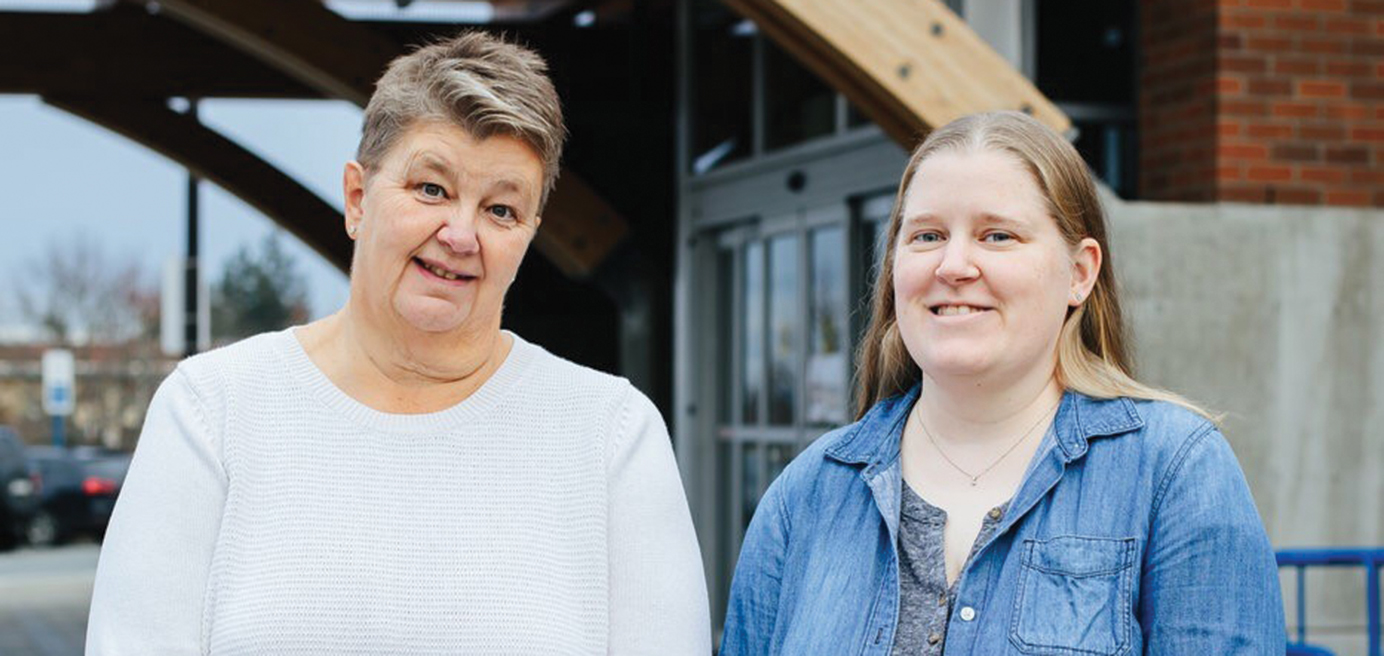 Advocating For Youth Mental Health Services
Advocating For Youth Mental Health Services

SAVOURING SUCCESS Nanaimo Regional General Hospital nurses Julia Sewell and Jennifer Jensen are happy with the outcome of a professional responsibility process that has seen the facility add a dedicated space for community youth mental health patients.
The need for appropriate youth mental health services has been identified as a critical area of concern for BC's health-care system. Youth mental health admissions continue to rise, and today adolescents with mental health crises wait–in some cases for days–in emergency departments across the province.
Add to this a growing number of youth presenting with substance use issues and it becomes clear that more action is needed. As far back as 2014 the province's representative for children and youth called on the government to begin providing appropriate care for children and youth who have multiple vulnerabilities.
The health-care system today is still short on the skilled staff and physical infrastructure need to care for young adults. Julia Sewell works on the Psychiatric Emergency Services (PES) unit at Nanaimo Regional General Hospital (NRGH). In early 2017 she identified this problem at her facility and initiated the professional responsibility process (PRP) to document a recurring situation she felt was endangering the care of children and adolescent psychiatric patients.
PRP language in the Nurses' Bargaining Association contract allows nurses to engage in productive dialogue with their employers over practice conditions that may be compromising safe patient care. The process is designed to identify problems and resolve issues without involving blame.
NRGH's PES unit is an adult psychiatric unit located within the hospital's emergency department (ER). Sewell was concerned about the fact that there was no allocated safe space on her unit to assess youth presenting with mental health or substance issues, away from potentially traumatic exposure to adults with unstable or inappropriate behaviours.
The only possible alternative for this population – known as community youth mental health substance use (CYMHSU) patients – was to move them to the hospital's pediatric unit, but this area lacked an appropriate physical environment to treat children admitted for psychiatric or non-medical reasons. In addition, the pediatric nurses working there were not required to have the psychiatric training needed to properly assess adolescent patients.
It had become clear to Sewell and others at the hospital that these CYMHSU patients were falling into a gap in the continuum of care.
- Jennifer Jensen
NRGH pediatric unit nurse Carly Tarr shared Sewell's concerns, and knew that her unit was also no place for these youths.
"Pediatrics is an eight-bed unit that's only covered by two full-time nurses at any given time" she explains. "We were lacking a safe space for these kids who are a bit too dysregulated to be admitted to the pediatrics unit but also too young to be admitted to the adult-centered psychiatric emergency area."
Jennifer Jensen works with Sewell on the PES unit. The nurse also voiced her concerns using the professional responsibility process. "At that time there were no age guidelines for intake; we did our best not to have minors on the unit, but there really wasn't any other place to service them and so that became the essence of our PR concern."
"We were all very uncomfortable with the fact that we had all too often been trying to care for a minor on a very active, very acute psychiatric unit."
Nurses start the PR process by having a conversation with their manager and if that doesn't result in action, they move to step two and fill out a professional responsibility form (PRF).
Sewell first brought nurses' concerns to managers' attention in early 2017. "I recall having a meeting with management and we discussed the problems as we saw them. But managers soon wanted to go to the next level [of the PR process] as other nurses with similar concerns became involved," she says. "We sat down with administration and had a round-table discussion as a team."
Afterwards, Sewell, Jensen and other nurses working on the PES unit, pediatrics and in the ER documented their concerns on PRFs, which were then forwarded to the worksite Professional Responsibility Committee (PRC). This committee is comprised of two co-chairs representing the union and the employer, the nurses with the concerns, the union steward, immediate supervisor and the excluded manager.
A PRC meeting was then called and nurses in the three affected units, management and hospital leadership all displayed a unified desire to resolve the issue. Various strategies were discussed and significant recommendations were then made: designing an algorithm to use when adolescent youth presented to the ER with signs of mental health issues, creation of appropriate safe space for these children, and creating a policy that sets the minimum age for admission to the PES unit at 16.
However, several children under the age of 16 continued to be admitted to the PES unit while the group waited for an evaluation of the newly adopted algorithm simply because there was no other appropriate place to hold them.
The problems persisted despite the policy and practice changes that were eventually put in place. The nurses decided that the agreed-to changes were not sufficient to resolve the issues at the worksite level and the PRC co-chairs agreed to recommend advancing the matter to the Senior Review Committee (SRC).
"It truly was about the physical space," Jensen says. "We certainly needed more education and skills to care for that age group, but our primary concern was not how we dealt with them from a nurse-to-patient point of view, but where we cared for them so that we're not exposing them to all that acuity."
Under the PRP language that these nurses used, when a professional practice issue couldn't be resolved or decided at the local level it was advanced to the SRC, the third step of the PRP.*
The SRC meets with frontline nurses and listens to their challenges and then meets with leadership to navigate the challenges that staff are facing. Follow-up is critical to ensure they have all the information to discover, and then recommend, appropriate solutions.
Throughout the process, the NRGH nurses were assisted by Pacific Rim region PR advocate Sharon Fulton, who also helped by consulting with experts in community mental health, like Comox Valley's Deidre Knudson. "There's been a historic lack of support for this specific [CYMHSU] population, and we wanted to look at the big picture so we could make a [recommendation] to really keep this population safe," Knudson explains.
Nurses representing the NRGH PES unit, pediatrics and the ER spoke at an SRC hearing in early 2019, imploring the committee to help the hospital implement the changes they believed were desperately needed.
Their proposals included creating the physical space required to properly care for adolescent youth; providing pediatric nurses with psychiatric education, and hiring child, youth and family crisis nurses who could work on all of the affected units to effectively care for the children and youth at NRGH.
But the multiple units affected made the committee's job of assessing these proposals somewhat more challenging. BCNU West Kootenay region executive member Glenna Lynch was BCNU's representative on the SRC.
"Typically we would just be addressing issues related to one unit," she says, "and although this PR process originated in the hospital's PES unit, the SRC decision would also impact the ER and pediatric unit – and we would also need to take community mental health services into consideration."
She explained that her SRC co-chair Dawn Nedzelski, who was the employer representative and Island Health chief nursing officer, needed to hear from nurses in all of the units involved to understand how the continuum of care for CYMHSU patients – and the staff caring for them – would be affected.
"When you look at a health authority and what it takes to create new policy and procedure - the levels of regulation can be extensive and time-consuming," explains Lynch.
Despite this challenge, she firmly believes the SRC's collaborative approach to problem-solving helped it arrive at a solution. "There was no 'us and them,'" she states. "We had a communications process where the front-line staff actually got to convey what happened with their patients directly to the CNO, who has the ability to make change."
Success came when the SRC issued its report stating that its recommendations were made with a view to shifting care from simply providing a safe environment during crises to providing accessible, specialized multidisciplinary care.
SRC recommendations are unanimous and binding. In this case they required Island Health to provide accessible, physical space for CYMHSU patients, design focused psychiatric education for pediatric and ER nurses required to care for this patient population and establish crisis nurse positions in the ER equivalent to 3.3 new full-time positions.
Following the SRC report, Island Health began converting one of the existing quiet rooms in the ER into the dedicated safe space for youth.
Fulton reports that the child, youth and family crisis nurses began their new positions on November 25, 2019. "Three of the four positions have been filled, with one more position to be hired in the near future."
She confirmed that the new positions will be staffed from 8:00am to 4:00pm and from 3:30pm to 11:30pm seven days a week to coordinate and oversee the care for youth in need.
"This was such an amazing file to be a part of," remarks Lynch. "I was so impressed and proud to see all these health-care workers come together to advocate for better care and appropriate space – it will have a positive impact on the continuum of care for these kids." •
* These members' professional responsibility initiative followed the process that existed under Article 59 of the now expired 2014-19 NBA collective agreement. A new process was negotiated and is now in effect under the terms of the 2019-22 NBA agreement. Details can be found at www.bcnu.org
UPDATE (Dec 2019 / Jan 2020)

